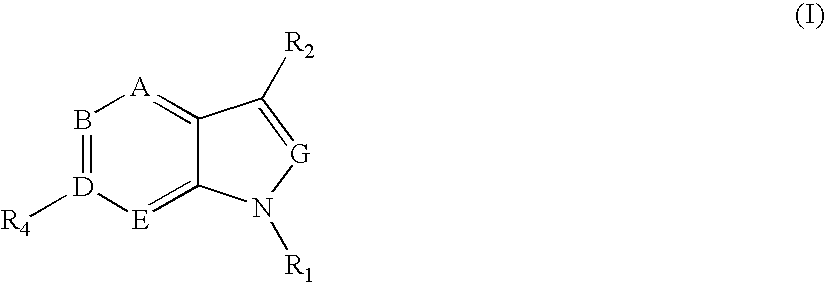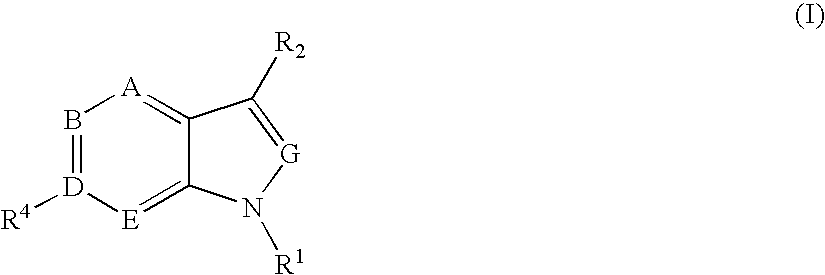6' substituted compounds having 5-ht6 receptor affinity
a substituted compound and receptor technology, applied in the field of serotonin 5ht6 affinity, can solve the problems of lack of selective agonists and antagonists, and hinder the in vitro investigation of receptor function
- Summary
- Abstract
- Description
- Claims
- Application Information
AI Technical Summary
Benefits of technology
Problems solved by technology
Method used
Image
Examples
example 1
Synthesis of 2-methyl-1,2,3,4-tetrahydroisoquinoline-8-sulfonyl chloride
Synthesis of 5-bromoisoquinoline
Into a 250 mL 3-necked round-bottom flask was placed H2SO4 (150 mL). To the above was added isoquinoline (17 g, 131.62 mmol) in several batches, while cooling to a temperature of 0° C. To the above was added NBS (29.2 g, 164.04 mmol) in several batches, while cooling to a temperature of −25-22° C. The resulting solution was allowed to react, with stirring, for 2 hours while the temperature was maintained at −25-22° C. The resulting solution was allowed to react, with stirring, overnight while the temperature was maintained at room temperature. The reaction progress was monitored by TLC (ethyl acetate / petroleum ether=1:5). The reaction mixture was then quenched by the adding 1000 mL of H2O / ice. Adjustment of the pH to 8-10 was accomplished by the addition of NH3. H2O (30%). The resulting solution was extracted four times with 500 mL of ethyl acetate and the organic layers combined ...
example 2
Synthesis of 4-methyl-3,4-dihydro-2H-benzo[b][1,4]oxazine-6-sulfonyl chloride
Synthesis of 3,4-dihydro-2H-benzo[b][1,4]oxazine
Into a 250 mL 3-necked round-bottom flask, was placed a solution of lithium aluminum hydride (3.6 g, 94.74 mmol) in THE (80 mL). The mixture was stirred for 15 minutes. This was followed by the addition of a solution of 2H-benzo[b][1,4]oxazin-3(4H)-one (5.7 g, 38.22 mmol) in THF (21 mL), which was added dropwise with stirring. The resulting solution was allowed to react, with stirring, overnight while the temperature was maintained at reflux in a bath of oil. The reaction progress was monitored by TLC (ethyl acetate / petroleum ether=1:1). The reaction mixture was then quenched by the adding 3.6 mL of H2O and 10.8 mL 15%NaOH. A filtration was performed. The filter cake was washed 1 time with 30 mL of THF. The resulting solution was extracted two times with 100 mL of ethyl acetate and the organic layers combined and dried over Na2SO4 and concentrated by evaporati...
example 3
Synthesis of 2-oxo-1,2,3,4-tetrahydroquinoline-7-sulfonyl chloride
Synthesis of ethyl 3-phenylpropanoate
Into a 500 mL 3-necked round-bottom flask was added a solution of ethyl cinnamate (10 g, 56.75 mmol) in MeOH (200 mL). To the mixture was added Pd / C (2 g) followed by hydrogen. The resulting solution was allowed to react, with stirring, overnight while the temperature was maintained at 35° C. in a bath of oil. A filtration was performed. The filtrate was concentrated by evaporation under vacuum using a rotary evaporator. This resulted in 10 g (99%)of ethyl 3-phenylpropanoate as a colorless oil.
2. Synthesis of ethyl 3-(2,4-dinitrophenyl)propanoate
Into a 250 mL 3-necked round-bottom flask, was placed a solution of fuming HNO3 (25 mL) in cone. H2SO4 (50 mL). To the mixture was added ethyl 3-phenylpropanoate (5 g, 28.09 mmol), while cooling to a temperature of 0° C. The resulting solution was allowed to react, with stirring, for 1 hour while the temperature was maintained at 0° C. The ...
PUM
| Property | Measurement | Unit |
|---|---|---|
| Pharmaceutically acceptable | aaaaa | aaaaa |
| Affinity | aaaaa | aaaaa |
Abstract
Description
Claims
Application Information
 Login to View More
Login to View More - R&D
- Intellectual Property
- Life Sciences
- Materials
- Tech Scout
- Unparalleled Data Quality
- Higher Quality Content
- 60% Fewer Hallucinations
Browse by: Latest US Patents, China's latest patents, Technical Efficacy Thesaurus, Application Domain, Technology Topic, Popular Technical Reports.
© 2025 PatSnap. All rights reserved.Legal|Privacy policy|Modern Slavery Act Transparency Statement|Sitemap|About US| Contact US: help@patsnap.com



